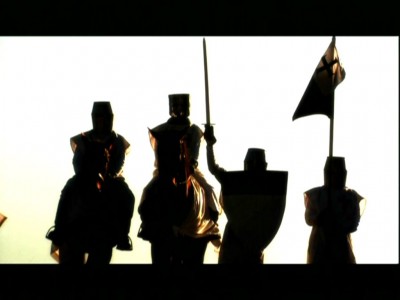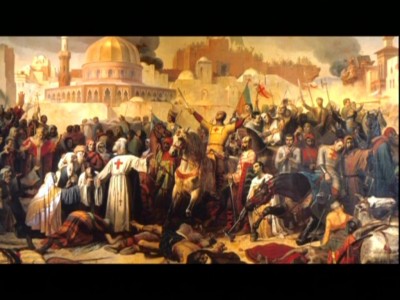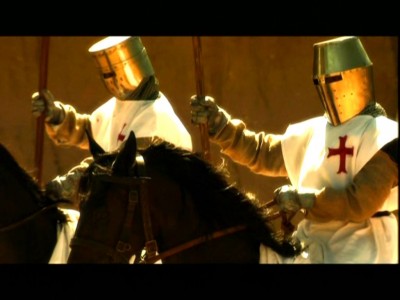| Reviews & Columns |
|
Reviews DVD TV on DVD Blu-ray 4K UHD International DVDs In Theaters Reviews by Studio Video Games Features Collector Series DVDs Easter Egg Database Interviews DVD Talk Radio Feature Articles Columns Anime Talk DVD Savant Horror DVDs The M.O.D. Squad Art House HD Talk Silent DVD
|
DVD Talk Forum |
|
|
| Resources |
|
DVD Price Search Customer Service #'s RCE Info Links |
|
Columns
|
|
|
Templar Code (Decoding the Past), The
History has released The Templar Code, a beautifully shot, entertaining 2005 episode of their Decoding the Past series. Split up into two parts, The Templar Code, through interviews with authors/experts on the subject, narration, live-action recreations, location shooting, maps, and various works of art, traces the origins of that most powerful of the Middle-Ages religious/military orders, up through their peak years in the 1100s, to their swift decline after Jerusalem fell to the Turks in 1244, and France's King Philip IV's and Pope Clement V's decimation of the Order in 1307. Tantalizing theories are also proffered about the lasting legacies of the Templars (did they really invent the Swiss banking system?), a subject that has recently garnered tremendous public interest due to works of fiction like The Da Vinci Code.

Just to be upfront here, I should state I'm certainly no expert or even a novice on Templar history or this historical time period, for that matter, so what little actual information I convey in this review comes from the source - the documentary. There are quite a few blogs out there devoted to debating the accuracy (or lack thereof) of mainstream History docs, so all experts with differing opinions, be forewarned. Authors/experts used for The Templar Code include George Smart, Dr. Tim Wallace-Murphy, Marilyn Hopkins, Sean Martin, Alan Butler, and Dr. Karen Ralls, and their interviews are intercut with the other filmed material in the standard TV history doc fashion. The Templar Code begins with a brief background on the Crusades, marking it as much a clash between major powers as a war of religion and culture (Christian kings, feeling that Muslim inroads were being made on their far-flung borders, decided war was the answer). Pope Urban II's declaration, at the Council of Clermont, of an "indulgence" for all future warriors, swelled the crusader ranks, and by 1099, Jerusalem was returned to Christendom. According to legend, the Templars evolved around 1119 as a band of monastic knights whose self-appointed duty was to protect the Christian pilgrims who made the trek to the Holy Land from the West. The Templar Code calls that legend into question, though, while proffering more theories about the Templars, including that they were archeologists/treasure hunters, looking for sacred relics underneath their temple headquarters at the old Temple of Solomon site, on the Temple Mount, where supposedly the Arc of the Covenant and the Ten Commandments were kept.
Offering many theories (but not a lot of in-depth research, as owing to the nature of these kinds of television documentaries), The Templar Code then looks at the rise of the Templars as a independently wealthy, politically influential, and militarily superior force that operating within Europe - while answering to no laws other than those of the Pope's. With the public support of Bernard of Clairvaux (who wrote A New Knight, extolling the virtues of the Templars), as well as numerous successful military campaigns (the most spectacular being the Battle of Montgisard in 1117, where just 500 hundred Templars routed Muslim Sultan Saladin's army of 26,000 soldiers). The Templar Code makes it clear, though, that only a relatively small percentage of Templar knights were actually warriors; the vast majority of Templars were businessmen who helped invent today's modern banking system with their use of the equivalents of checks and lines of credit for Holy Land pilgrims wishing to thwart thieves along the path to Jerusalem. Soon, the Templars were receiving huge tracts of land through recruitment drives, acquiring more and more power and wealth as they began their role as power brokers with European kings, lending them money for their various wars.

With the ongoing Crusades going badly (1187's Battle of the Horns of Hattin was the tipping point for the Muslims), support for the Templars (and indeed, a raison d'etre for their continued presence) began to dwindle. The secrecies of the Order, however, would prove to be the Achilles' heel of the Templars, providing a convenient propaganda tool for France's King Philip IV (who was heavily in debt to the Templars) to smash the Order and wipe out his balance sheet. With many French Templars arrested on Friday, October 13, 1307, accused of outlandish sexual and religious heresies in their secret initiation rites, and with the later aid of Pope Clement's papal bull that called for the arrest of all Templars and the seizure of their monies, the Order was dealt a death blow from which it never fully recovered. Torture and burnings at the stake followed for some Templars, while the majority of knights either fled their respected countries, or quietly blended into the woodwork. Or...did they emigrate to Switzerland, training farmers to be warriors there, and instilling their love of secrecy and banking to the Swiss? Or did they escape by their fleet of ships, and join Robert the Bruce in his battle against the English in 1317? The Templar Code offers up these theories for contemplation, but the academic jury is still out on the what really happened with the Templars.
Visually, The Templar Code is certainly slick and professional looking, with gorgeous on-location shooting of the various Templar battle sites, as well as Temple-built churches and administrative buildings throughout Europe. Kept moving along at a swift pace, The Templar Code, directed and shot by Geoffrey Madeja, and written by Marcy Marzuki, is an entertaining introduction to the history of the Knights Templar - particularly for novices like myself.

The DVD:
The Video:
The non-anamorphic, 1.78:1 letterboxed video transfer for The Templar Code is clean and sharp, although some compression artifacting was apparent at times (not an unheard of - or unexpected - trait for History DVDs). Colors are correctly valued, and detail is good.
The Audio:
The Dolby Digital English 2.0 stereo audio mix is adequate (if unspectacular) for this largely dialogue-driven documentary. All dialogue is cleanly heard. No subtitles or close-captions are available.
The Extras:
There are no extras for The Templar Code.
Final Thoughts:
Beautifully shot and quite entertaining, The Templar Code is a fairly typical History doc in form and content, offering a good introduction to the subject...for those new to it. A rental is still called for here (because buffs probably already know all this, and newcomers may only need to see it once to get them started).
Paul Mavis is an internationally published film and television historian, a member of the Online Film Critics Society, and the author of The Espionage Filmography.


|
| Popular Reviews |
| Sponsored Links |
|
|
| Sponsored Links |
|
|
| Release List | Reviews | Shop | Newsletter | Forum | DVD Giveaways | Blu-Ray | Advertise |
|
Copyright 2024 DVDTalk.com All Rights Reserved. Legal Info, Privacy Policy, Terms of Use,
Manage Preferences,
Your Privacy Choices | |||||||














